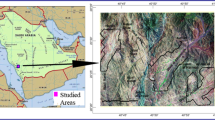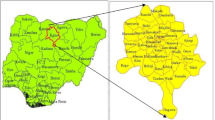Abstract
The Al Aziziah area is built on volcanic and granitic rocks. The igneous rocks always contain a high amount of naturally radioactive elements such as uranium, thorium and potassium, which produce gamma rays causing environmental hazards when exceeding the permissible limit. Radon gas is a result from the decomposition of uranium/thorium leaks into enclosed areas (e.g. homes or offices). This leakage is controlled by many conditions, and one of them is the underlining rock type. To work on such an environmental study, a gamma ray spectrometer survey was used. The uranium, thorium and potassium contents, as well as their ratios and the total radiation, were determined and mapped. The radiation dose rate was calculated and mapped in mSv/y and nGy/h units. The radiation contamination of groundwater is detected from the contour map of the dose rate over the artificial drainage lines of rains and floods which move this water to the groundwater wells. The main results are as follows: granitic rocks show an average dose rate of about 2.4 mSv/y, while the deposits of these rocks have an average dose rate of 1.2 mSv/y. A low average dose is recorded over the basalt. The average radiation dose recorded in the study area is 1.08 mSv/y, while its range is from 0.001 to 4.41 mSv/y. The estimated effective doses within the Al Aziziah area and vicinity area were higher than 1 mSv/y, which is the public exposure limit, and lower than the occupational exposure limit of 20 mSv/y. We recommend ventilating homes and offices in these places on an ongoing basis and constant radon measuring in closed places.


















Similar content being viewed by others
References
Aboud, E., Alqahtani, F., & Aboelnaga, H. O. (2019). Radiation map for King Abdulaziz University campus and surrounding areas. Journal of Radiation Research and Applied Science, ISSN: (Print), 1687–8507.
Al-Kawazini, A. T., Said, A. J., & Attaelmanan, A. J. (2016). The enhancement of background radiation as a result of using natural building materials. Journal of Community Medicine & Health Education, 6, 482.
Al-Shanti, A. M. (2009). Geology of the Arabian shield of Saudi Arabia (Vol. 2009, p. 190). King Abdulaziz University: Scientific Publishing Center.
Bamousa, A. O., & Maghraby, M. (2016). Groundwater characterization and quality assessment, and sources of pollution in Madinah, Saudi Arabia. Arabian Journal of Geosciences, 9. https://doi.org/10.1007/s12517-016-2554-z.
Bollhöfer, A., Pfitzner, K., Ryan, B., Martin, P., Fawcett, M., & Jones, D. R. (2008). Airborne gamma survey of the historic Sleisbeck mine area in the Northern Territory, Australia, and its use for site rehabilitation planning. Journal of Environmental Radioactivity, 99, 1770–1774.
Clarke Jr., S. P., Peterman, Z. E., & Heier, K. S. (1966). Abundances in uranium, thorium and potassium. In Handbook of physical constants, Geological Society of America, Memoir (Vol. 97, pp. 521–541).
Cook, S. E., Corner, R. J., Groves, P. R., & Grealish, G. J. (1996). Use of airborne gamma radiometric data for soil mapping. Australian Journal of Soil Research, 34(1), 183–194.
Dierke, C., Werban, U. Dietrich, P., (2011). Towards a better understanding of γ-ray for soil mapping – analysis of γ-ray measurements at field sites across Europe. The Second Global Workshop on Proximal Soil Sensing, Montreal, Canada.
Drovnikov, V. V., Egorov, N. Y., Kovalenko, V. V., Serboulov, Y. A., & Zadorozhny, Y. A. (1997). Some results of the airborne high energy resolution gamma-spectrometry application for the research of the USSR European territory radioactive contamination in 1986 caused by the Chernobyl accident. Journal of Environmental Radioactivity, 37(2), 223–234.
Hedley, C. B., Roudier, P., & Peterson, P. (2016). Gamma soil surveys- investigating soil patterns for nutrient and water management. In L. D. Currie & R. Singh (Eds.), Integrated nutrient and water management for sustainable farming, Occasional report no. 29 (p. 8). Palmerston North, New Zealand: Fertilizer and Lime Research Centre, Massey University Retrieved from http://flrc.massey.ac.nz/publications.html.
ICRP (2000). Publication 60, Recommendations of the International Commission on Radiological Protection, in ICRP Publication 60. Oxford: Pergamum Press Annals of ICRP. Retrieved from http://www.icrp.org/docs/2000_Ann_Rep_52_261_01a.pdf.
International Atomic Energy Agency. (1979). Atomic energy review (Vol. 17). Vienna: IAEA.
International atomic energy agency. (1989). Construction and use of calibration facilities for radiometric field equipment, technical reports series no. 309. Vienna: IAEA.
International Atomic Energy Agency (2000). 5th international conference on high level of natural radiation, Munich, 2000. (Waste solutions, Vol.42 No3, Vienna, Austria, p7).
International Atomic Energy Agency (IAEA) (1991) Airborne gamma-ray spectrometer surveying. IAEA, Vienna, Austria, Technical Report Series No. 323, 97 p.
Jiang, Y., & Yan, J. (2010). Effects of land use on hydrochemistry and contamination of karst ground-water from Nandong underground river system, China. Water, Air, and Soil Pollution, 210, 123–141.
Løvborg, L. (1984). The calibration of portable and airborne gamma ray spectrometers - theory, problems and facilities. Report Riso-M-2456, Roskilde.
Mohamed, R. I., Alghadi, S. K., & Al-Shamani, N. S. (2016). Evaluation of radionuclide concentrations and associated radiological hazard in marble indices and granite used as building materials in Al-Madinah Al-Munawarah. Journal of Taiba University for Science, 10, 369–374.
National Academy of Sciences (2006). Health risks from exposure to low levels of ionizing radiation: BEIR VII phase 2 424 pages | 8 1/2 x 11 | PAPERBACK ISBN 978–0–309-09156-5 https://doi.org/10.17226/11340
Nisi, B., Buccianti, A., Vaselli, O., Perini, G., Tassi, F., Minissale, A., et. (2008), “Hydrogeochemistry and strontium isotopes in the Arno River Basin (Tuscany, Italy): constraints on natural controls by statistical modeling”, Journal of Hydrology, 360, 166–183.
Osman, G., Aközcan, S., & Kulalı, F. (2019). Measurement of indoor radon concentration and annual effective dose estimation for a university campus in Istanbul. Arabian Journal of Geosciences, 12, 171.
Pellaton, C. (1981) Compiled geologic map of al Madinah Quadrangle, Sheet24D, Kingdom of Saudi Arabia.
Pracilio, G., Adams, M. L., Smettem, K. R. J., & Harper, R. J. (2006). Determination of spatial distribution patterns of clay and plant available potassium contents in surface soils at the farm scale using high resolution gamma ray spectrometry. Plant and Soil, 282(1–2), 67–82.
Sanderson, D. C. W., Cresswell, A. J., Hardeman, F., & Debauche, A. (2004). An airborne gamma-ray spectrometry survey of nuclear sites in Belgium. Journal of Environmental Radioactivity, 72, 213–224.
Singh, V., & Chandel, C. P. S. (2006). Analysis of wastewater of Jaipur city for agricultural use. Research Journal of Chemistry and Environment, 10(1), 30–33.
Spadoni, M., & Voltaggio, M. (2013). Contribution of gamma ground spectrometry to the textural characterization and mapping of floodplain sediments. Journal of Geochemical Exploration, 125, 20–33.
UNSCEAR (1988). Sources, effects and risks of ionizing radiation. United Nations Scientific Committee on the effects of atomic radiation. Report to the General Assembly on the Effects of Atomic Radiation.
UNSCEAR (1993). United Nations Scientific Committee on the Effects of Atomic Radiation, Sources and effects of ionizing radiation. Report to General Assembly with Scientific Annexes. United Nations, New York.
UNSCEAR (2000). Sources and effects of ionizing radiation. United Nations Scientific Committee on the Effects of Atomic Radiation, UNSCEAR Report to the General Assembly, with scientific annexes. 2000; Vol. 1.
UNSCEAR (2017). Sources, effects and risks of ionizing radiation. Report to the general assembly and scientific annexes A and B. UNSCEAR 2012 report. United Nations Scientific Committee on the Effects of Atomic Radiation. United Nations sales publication E.16.IX.1. United Nations, New York, 2015.
WHO (World Health Organization) (2011) Guidelines for drinking-water quality. 4th ed, Geneva 541 [electronic resource].
Acknowledgements
The data in this study refers to a project which was funded by the Deanship of Scientific Research (DSR), King Abdulaziz University, Jeddah, under Grant No. G-1368-869-1440. The authors, therefore, acknowledge the technical and financial support of DSR with gratitude.
Author information
Authors and Affiliations
Corresponding author
Additional information
Publisher’s note
Springer Nature remains neutral with regard to jurisdictional claims in published maps and institutional affiliations.
Rights and permissions
About this article
Cite this article
Abuelnaga, H.S.O., Harbi, H.M., Alqahtani, F.A. et al. Radiological environmental studies of Al Aziziah area and vicinity, Al Madinah Al Monawarah, Saudi Arabia. Environ Monit Assess 193, 87 (2021). https://doi.org/10.1007/s10661-021-08883-9
Received:
Accepted:
Published:
DOI: https://doi.org/10.1007/s10661-021-08883-9




